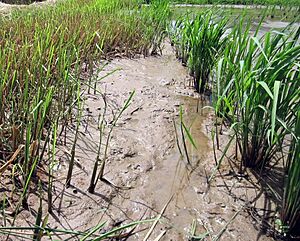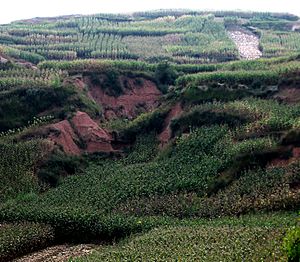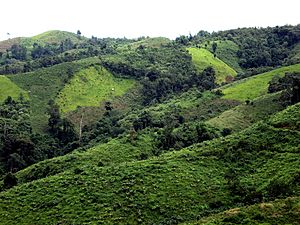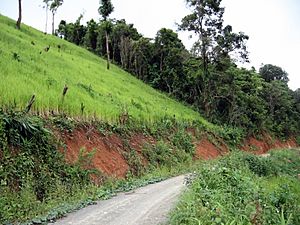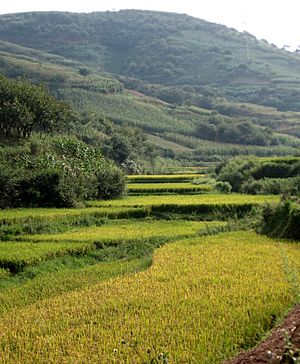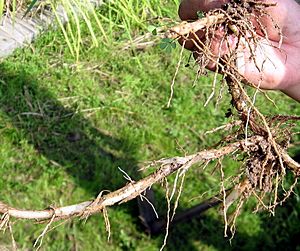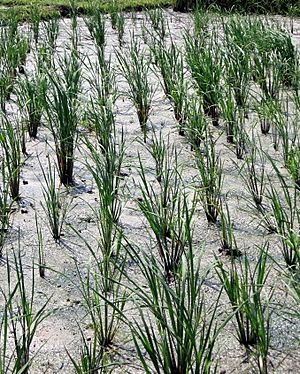Perennial rice facts for kids
Perennial rice is a special kind of rice that can grow back year after year. Unlike regular rice, farmers don't need to plant new seeds every season. Scientists called plant geneticists are working to create these amazing rice types.
These new rice plants are called "perennial" because they live for many years. Just like other perennial plants, they can spread using stems that grow underground or just above the soil. They also make flowers, pollen, and seeds. Humans harvest and eat these seeds, just like with any other grain.
Perennial rice is one of several perennial grains being developed. Other examples include perennial wheat and sorghum. Experts say that having more perennial crops helps make the soil healthier. It also provides a home for wildlife.
The first research on perennial rice started at the International Rice Research Institute in the Philippines. Now, the Yunnan Academy of Agricultural Sciences in China and other places are developing it. These new rice types are not yet ready for farmers to use.
Contents
Perennial and Annual Rice: What's the Difference?
How Regular Rice Grows
Most Asian rice, called Oryza sativa, is an annual plant. This means it lives for only one growing season. After it produces seeds, the plant usually dies. Sometimes, if conditions are good, it can grow back a second time. This is called "ratooning."
In warm places, farmers might grow two or three rice crops each year. For most crops, this means they must remove the dead plants. Then, they prepare the soil and plant new seeds every few months. This takes a lot of work.
How Perennial Rice Grows
The wild ancestor of Asian rice, called Oryza rufipogon, often lives for many years. It produces seeds every year and spreads using its stems. Some O. rufipogon plants are annual, but many are perennial.
Other wild rice types in the Oryza family are also perennial. For example, Oryza rufipogon spreads with stems that grow above ground. But O. longistaminata and O. officinalis spread with underground stems called rhizomes.
Why Perennial Rice is Helpful
Less Soil Erosion
Farm fields, especially in warm, wet places, can lose soil easily. This happens when plants are removed or the soil is plowed. Wind and water can wash away the soil and its nutrients. This also makes the soil packed down and less healthy.
When soil washes away, fields become less productive. The soil and nutrients can also pollute rivers and oceans. This can harm fish and other water life. It can also fill up reservoirs and waterways with mud.
Perennial plants grow back quickly after harvest. This means they keep the soil covered and protected. Farmers do not need to plow the fields again after the first planting. This helps keep the soil in place.
Researchers at the International Rice Research Institute believe perennial rice will help food production. They think it will make farming more sustainable in hilly areas.
Protecting Forests
A perennial rice that produces a lot of food could help farmers around the world. They could grow food on the same land for a very long time. Today, many farmers clear parts of the forest for their crops. After the soil loses its nutrients, they leave the land and clear a new part of the forest.
This "slash-and-burn" farming can harm the environment. It causes loss of different plants and animals. It also releases carbon dioxide into the air. This practice can be reduced if farmers can keep their soil healthy.
Other Benefits of Perennial Crops
- Better in Dry Times: Regular rice has shallow roots and struggles in droughts. A perennial plant can grow deep, strong roots. These roots can reach more water in the soil. Also, soil that isn't plowed stays moist longer.
- Fewer Weeds: Weeds can be a big problem for rice farmers. Perennial plants can grow thick and strong. Once they are established, they can stop weeds from growing.
- More Nutrients: Shallow-rooted plants like regular rice get most of their food from the top layer of soil. Deep-rooted perennial plants can get nutrients like phosphorus from deeper down. This is very helpful in soils that don't have many nutrients.
- Less Hard Work: Perennial rice could reduce the need for transplanting and weeding. These tasks are very hard work for farmers.
- Better Use of Fertilizer: Perennial plants might use fertilizers more efficiently.
Possible Challenges
- More Pests: If fields are not left empty for part of the year, rodents and insects might increase. Burning the leftover rice stalks could reduce pests. But burning might not be allowed everywhere. Also, pests living underground would survive burning.
- Harder Crop Rotation: Changing crops in a field is called crop rotation. It helps keep the soil healthy and reduces pests. With perennial plants, crop rotations would take longer. This could allow pests or diseases to build up more easily.
- Water Use: Perennial plants might use more rainfall than annual plants. This could cause water levels in the ground to drop. It could also reduce water flowing into rivers.
- Less Nutrients Downstream: If many farms switch to perennial plants, less soil and nutrients might wash into rivers. This is good for water quality. But farmers downstream who rely on these nutrients might get less.
Where Perennial Rice Could Grow Best
Upland Rice Areas
Upland rice grows on hills in southern China and Southeast Asia. Because it grows on steep slopes without flat terraces, a lot of soil washes away. A piece of land can only grow rice for a year or two before it needs to rest. Then, the forest grows back, only to be cleared again later.
As more people need food, these resting periods are getting shorter. This causes the soil to become very poor. If rice were perennial, its roots would stay alive all the time. This would stop soil from washing away, just like grass on a hillside. Perennial rice could produce food year after year on the same land without harming the soil.
Rainfed Paddy Rice Areas
About 26% of the world's rice fields are terraced but not irrigated. These fields get water only from rain. This system produces about 17% of the world's rice.
Even though soil erosion is less of a problem here, perennial rice could still help. Farmers in these areas face droughts one year and floods the next. They are always managing risk. Because the rainfall is unpredictable, many farmers do not use expensive fertilizers.
Rice with deeper roots, like perennial rice, could find more water and nutrients in the soil. The perennial nature could also make planting easier when rainfall is uncertain. The underground stems (rhizomes) would simply wait until the weather is right to grow.
Irrigated Paddy Rice Areas
Irrigated rice fields are very productive. This farming method has been used in China for thousands of years. But even here, perennial rice could offer some benefits.
- Stronger Plants: Sometimes, mixing two different rice types creates an extra strong plant. If this special plant is perennial, farmers could make millions of copies from its underground stems.
- Easier Breeding: If scientists create a great new rice plant, they can easily make more copies of its "parents" if they are perennial. This helps them create new seeds faster.
- More Harvests: In some places, farmers could get more rice harvests each year. This is because new shoots from the perennial plant grow faster than from seeds. This also reduces the need for transplanting seedlings, which takes a lot of time and effort.
Other benefits in these areas include:
- Less need for transplanting, weeding, and other hard work. Many rural areas in Asia have fewer farm workers now.
- More efficient use of fertilizers.
History of Perennial Rice Research
Early Research in Thailand (1990s)
Drs. Dayun Tao and Prapa Sripichitt worked at Kasetsart University in Thailand. They tried to cross regular rice with wild, perennial rice types. This was very difficult. For example, to get just one successful plant from Oryza sativa and O. longistaminata, they had to pollinate 119 rice flowers. Only one of the resulting seeds grew into a healthy plant.
Another cross, between rice and O. rhizomatis, was even harder. They had to try over 3000 times to get just one plant! Luckily, the successful plant from the O. longistaminata cross was healthy and could make seeds.
Perennial Upland Rice Program in the Philippines (1990-2001)
To help with soil erosion in upland rice areas, the International Rice Research Institute (IRRI) started a program. They tried to breed perennial upland rice. They made good progress in just a few years.
They crossed regular rice with two different wild perennial types:
- Using O. rufipogon: This wild rice is an ancestor of cultivated rice. The new plants were often perennial and produced good amounts of rice. This showed that it was possible to breed for both high yield and perennial traits.
- Using O. longistaminata: This wild rice from Africa is very perennial and has strong underground stems (rhizomes). Rhizomes might help plants survive dry conditions better. However, this species is less related to cultivated rice. So, the crosses were much harder to make, and many of the new plants were not fertile.
Mapping Rhizome Genes in China (1999-2001)
Hu Fengyi, now a director at YAAS, worked on the IRRI project. He helped find the genes that control rhizome production in rice. They found two main genes, rhz2 and rhz3, that are needed for rhizomes in rice. These genes are also found in sorghum, another grain. This suggests that the change from perennial to annual happened a long time ago.
Scientists use markers for these genes to find plants that might be perennial.
Breeding New Plants in China (2007-Present)
The IRRI project ended in 2001 due to budget cuts. But the Yunnan Academy of Agricultural Sciences (YAAS) in China continued the research. They focused on plants from crosses with O. longistaminata because its rhizomes are very strong.
Finding the rare plants that have both rhizomes and can produce seeds has been a big challenge. They have to check many, many plants.
A new type of perennial rice, called PR23, has now been released. It allows farmers to grow rice without plowing the soil each year.
Goals for Perennial Rice Breeding
Making Seeds Fertile Again
Many of the hybrid rice plants are not able to produce seeds. Scientists are trying to find the genes that cause this problem. There are many such genes in rice.
Finding Rhizome Plants Quickly
- Marker-assisted selection: This method allows scientists to check many plants for rhizome genes very quickly. In the field, they first look for rhizomes, then for seed production, and finally for healthy pollen.
- Fine mapping: This helps scientists understand the rhizome genes better. It could even allow them to copy these genes and use them in new ways.
Removing Unwanted Genes
Wild rice species have some traits that farmers don't want. Scientists are trying to remove these unwanted genes from the new perennial rice. They do this by crossing the new rice with high-yielding regular rice types.
- Awns: Wild rice has sharp bristles called awns, but farmers prefer rice without them.
- Small seeds: Wild rice has small seeds. Larger seeds are easier to clean and grow more strongly.
- Grain quality: It is hard to make the new rice taste and cook like traditional rice varieties. There are thousands of local rice types with unique qualities.
- Low yield: When wild rice is crossed with high-yielding rice, the yield often goes down. However, even low-yielding wild rice can have genes that help increase yield.


